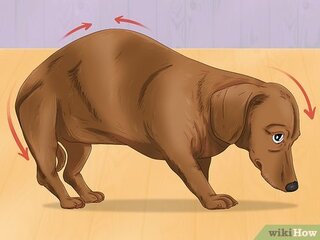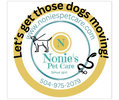|
Our pets ARE our emotional support dogs, although they may not be certified, they see us through everything. We should ALL return the love and favor to them when they are anxious, fearful, not feeling well, when they don't want to go for a walk outside and through thunderstorms and fireworks. If we aren't taking care of their feelings, like they take care of ours, you're doing something very wrong. If you have any questions about this, give me a call. I'm here to listen and help.
Here is some more "scientific" studies that support my blog post. Science has provided substantial evidence to support the idea that dogs have feelings and can form strong emotional bonds with humans. Here are some key findings and insights from scientific research on this topic:
Regenerate
0 Comments
Dogs experience the world differently from their human counterparts.
They have heightened physical senses and are aware of things we aren’t. Dogs can detect emotion, physiological changes (changes in the functioning of the body), illness, and environmental events, such as weather. This sensitivity is connected to their ability to see, smell, hear, and feel. They see fewer colors because of color blindness, and they see in higher contrast. This provides better night vision and the ability to track movement. A dog’s peripheral vision is wider, but they see less detail. There’s no contest when comparing a dog’s sense of smell to their human’s. A dog has about 300 million scent receptors compared with a human’s 6 million. A pup’s hearing also differs from ours. Dogs’ ears are built for hearing at higher frequencies than a human, but they don’t recognize changes in pitch as well as we do. In fact, there are many other differences between dog and human hearing. A dog’s fur and skin help them feel and process interactions with other animals, including humans. Pressure from a puppy playmate’s teeth can help communicate a need for less intense play. Given all of their incredible senses, dogs possess the ability to sense things about the world that may surprise you. 1. Can Dogs Sense Your Mood?You may wonder if your dog can sense when you’re sad or upset. Sadness, distress, anxiety, and anger are emotions, which trigger physiological responses in us. This can change our speech patterns, movements, posture, and smell. Since a dog’s senses are so heightened, they can detect these signals and be able to understand what happens next. For example, if you come home smiling and open your arms to your pup, they know you’re happy. They prance around and lean in for petting. They may even grab a toy because when you display this behavior, play typically comes next. Alternatively, if you come home angry, or quiet—going straight to your bedroom—your pup will know to steer clear. A human’s stress and anxiety are contagious to their dog. Dogs living with people who are chronically stressed are negatively affected in the long-term. This study captured emotional mirroring and the synchronization of stress levels of dogs with their pet parents. 2. Can Dogs Sense a Pregnancy?Though there’s no research confirming a dog’s ability to detect pregnancy, there are many stories of dogs changing their behavior when pet parent(s) become human parents. Given a dog’s ability to smell hormones and pheromones (a chemical, such as a scent, that signals behaviors like mating), it's likely that they can sense pregnancy. 3. Can Dogs Sense Fear?A dog is sensitive to fear in humans. When a dog perceives fear in a person through smell, body language, or facial expressions, it can result in behavior mirroring. This means a dog will show fear-based reactions in response to being exposed to a fearful human. Depending on the intensity of fear, this interaction may activate a dog’s fight or flight response. Responses can range from avoidant behaviors to reactive ones. If your dog deals with fear by running away (flight) or by biting (fight), it may be triggered by humans feeling tense, anxious, or afraid. One study examined dogs’ behavioral responses to a stranger after exposure to sweat samples—one collected from a happy human, the other collected from a frightened human. Overall, the dogs exhibited more social behaviors toward a neutral stranger after experiencing the “happy” sample and more avoidance after the “fear” sample. 4. Can Dogs Sense a Negative Person?Because negativity is more of an attitude than an emotion, it may have less impact on a dog. That said, if negativity causes stress and anxiety in a person, emotion and mood come back into the mix. When this happens, their dog could be affected. A negative person who is emotionally unpredictable has a unique chemosignal that dogs can detect. If those scents predict explosive or dangerous behavior, a dog learns to anticipate unsafe surroundings. 5. Can Dogs Sense Illness?Dogs’ ability to smell illnesses has been well documented. Typically, the biggest indicator of illness is through odor. Dogs can detect metabolic changes in our breath and through our skin. Most recently, a test was studied on dogs’ ability to detect COVID-19. Overall, the average rate of successful detection was 94%. 6. Can Dogs Sense When Someone Is Having a Seizure Or About To Have One?Seizures cause changes in a person’s physical appearance and facial expressions, thus alerting their pup that something isn’t right. Pet parents who experience seizures can train their pups to help them. However, not all dogs will alert a person of an impending event even if they can sense it. 7. Can Dogs Sense Cancer or Diabetes?Research has been conducted to determine whether dogs can detect cancer or diabetes. In samples including human tissue for cancer and exhaled breath for diabetes, dogs were able to sniff out infected samples and detect hypoglycemia (low blood sugar) in those who have diabetes. Particularly, dogs seem to notice the presence of melanoma, a form of skin cancer, in humans. Some untrained pups have repeatedly sniffed at a spot on the skin of a pet parent diagnosed with the disease. 8. Can Dogs Sense the Weather?Along with thunder and lightning, storms cause changes in barometric pressure (amount of air pressure in the atmosphere) and electrostatic charge (static electricity). When air pressure drops, scent moves down, collecting at ground level. This alerts a dog to changes in weather conditions. Static electricity builds up in a pup’s fur and creates small shocks as they move. Dogs are highly gifted companions with a heightened sense of the world around us. If you’re not sure how you’re feeling or feel as though something is off around you, watch your dog. They may be able to give you further insight.  Since Nonie’s opened its Special Needs Unit, we have had dogs with CHF, pets on complicated meds, pets with severe separation anxiety, even pets that are in their last days. We meet with your Vet first, obtain instructions, etc, and then handle their care if you must leave town. We make house calls or we place them on 24 hour watch; whatever your Vet recommends. When it comes to understanding our pets, we sometimes wish they could just tell us when something's wrong. While they can't communicate verbally like we do, they certainly have ways of expressing themselves. Recognizing the subtle signs of discomfort or pain in your pet is crucial for their well-being. Here's how you can decode some of these signs: 1. Behavioral Changes: Any sudden or gradual change in your pet's behavior can be a red flag. For instance: A normally playful pet suddenly becomes lethargic or withdrawn. An independent pet suddenly becomes clingy or vice versa. 2. Changes in Eating Habits: Eating less or not eating at all. Drinking more or less water than usual. 3. Vocalization: Whining, groaning, yelping, or more frequent meowing. Increased aggression or irritability when touched. Learn your pet’s language, they are communicating with you. Sometimes a cry or a whine isn’t for attention or boredom, he’s in pain. 4. Physical Signs: Limping or favoring one leg. Difficulty in rising from a resting position or reluctance to jump or climb stairs. Hunching over, a stiff gait, or altered posture. Swelling or heat in any area of the body. 5. Changes in Personal Hygiene: Grooming less often, leading to a dull or matted coat. Over-grooming or licking a specific area, which might indicate pain or itching. Unexplained weight loss or gain. 6. Altered Sleeping Patterns: Sleeping more than usual or difficulty sleeping. Restlessness or frequently changing positions. Did Buddy stop coming downstairs for breakfast? It might be because he doesn’t feel good or is having difficulty getting up and it’s painful. 7. Respiratory Changes: Panting or labored breathing in animals that typically don't pant. Increased heart rate. 8. Digestive Upsets: Diarrhea, vomiting, constipation, or straining during elimination. Blood in stool or urine. 9. Eye Changes: Cloudiness, redness, or frequent squinting. Increased tear production or discharge. 10. Hiding or Seeking Isolation: Many animals, especially cats, will hide or seek solitude when they are in pain or feeling unwell. What Can You Do? 1. Take Notes: Document any changes or symptoms. This can help your veterinarian pinpoint the issue. 2. Regular Check-ups: Routine veterinary visits can catch potential health problems before they become severe. 3. Trust Your Instincts: As a pet owner, you know your pet best. If something feels off, it probably is. 4. Seek Veterinary Advice: If you notice any of the signs mentioned above or other unusual behaviors, it's crucial to consult with a vet. 5. Provide Comfort: Ensure your pet has a comfortable resting place and is in a stress-free environment. 6. Avoid Self-diagnosis: While the internet is a trove of information, it's essential not to jump to conclusions or administer medications without consulting a veterinarian. In conclusion, our pets rely on us to notice when they're not feeling their best. By being attentive and proactive, we can ensure they receive the care they need. After all, they bring so much joy and comfort into our lives; it's only right that we do the same for them. Pets are the new kids and plants are the new pets!!! How Dogs Fill the Gaps in Our Lives: An Emotional and Psychological Perspective, Liz Schneider9/16/2023  Introduction: Roger Caras' famous quote, "Dogs are not our whole life, but they make our lives whole," beautifully encapsulates the profound impact dogs have on our emotional and psychological well-being. Beyond being our faithful companions, dogs serve as sources of comfort, joy, and enrichment in our lives. In this article, we'll delve into the emotional and psychological insights behind Caras' words, exploring the myriad ways in which dogs make our lives whole.
 1. Why Does My Cat Knead Me With Its Paws? Kneading, often referred to as "making biscuits," is when your cat rhythmically pushes in and out with their front paws. This behavior stems from their kittenhood when they would knead their mother's belly to stimulate milk flow. Adult cats continue this comforting behavior when they're content, signaling that they consider you a safe space. 2. The Mysterious Cat Chatter Have you ever noticed your cat staring out the window at birds or squirrels and making peculiar chattering or chittering noises? While the scientific community doesn't fully agree on why cats do this, a popular theory suggests it's a result of their predatory instincts. The chatter may be a frustrated response to seeing potential prey but being unable to catch it. 3. The Infamous Belly Trap It's a trap that many cat owners have fallen for: your cat rolls over, exposing its belly, and the moment you reach out to pet it, you are rewarded with a swift swat or bite. While dogs may show their belly as a sign of submission and a request for belly rubs, for cats, it's often a sign of trust and contentment. They're showing you their most vulnerable side, but it doesn't necessarily mean they want it touched. 4. Nighttime Zoomies Many cat owners are familiar with the burst of energy cats display, often during the wee hours of the night. This "midnight madness" or "zoomies" is a result of their natural hunting instinct. In the wild, cats are crepuscular, which means they're most active during dawn and dusk. This is the time when their prey is most likely to be active, so they have evolved to match this schedule. Providing plenty of play and enrichment activities during the day can help lessen these nighttime antics. 5. The Tail Tells a Tale A cat’s tail is like a mood barometer. A high, quivering tail indicates excitement and happiness, usually seen when your cat greets you after you've been away. A puffed-up tail indicates fear or aggression, a response to a perceived threat. A low or tucked tail suggests submission or defeat. Observing these tail signals can provide valuable clues about your cat's emotional state. Deciphering cat behavior can be a fascinating journey. While they are renowned for their mysterious demeanor, with some understanding of their instinctual behaviors, you'll find that your feline companion is also capable of a vast range of emotional expression. Remember that every cat is unique, so what holds true for one might not for another. Paying close attention to your cat's specific behaviors and responses will foster a stronger bond and a harmonious co-existence. Nonie’s Pet Care, LLC
Our Biggest Milestone Yet July 20, 2023 On July 20, 2023, we broke a record, we reached an impressive milestone of 1,002 visits for the month of July, and there are still days to go. Words cannot express the overwhelming sense of pride I feel in this moment. I am immensely grateful for my incredible team made up of degreed Vet techs and experienced pet handlers of all kinds. As the owner, there is no greater satisfaction than reaping the rewards of our hard work, meticulousness, and dedication to providing the best possible care for our clients and their beloved pets. The countless photos we provide, showcasing the happiness and playfulness of our furry clients, fill our hearts with joy. It's hard to believe that I started as a sole proprietor in Old Metairie back in 2011, and now we have grown to a team of 14, serving not only Metairie but also New Orleans, Kenner, Elmwood, Jefferson, Harahan, and River Ridge. The journey hasn't been without its challenges. Dealing with computer glitches, staff shortages, adverse weather conditions, personnel issues, and ensuring the well-being of everyone during impending hurricanes has tested our resilience. I have personally sacrificed vacations and even a haircut for two years (yes, a haircut!). I've had to replace the engine in my vehicle after reaching a dog in the midst of a flood. Many sleepless nights have been spent caring for sick or post-surgical pets in need of our assistance. I have provided support and guidance to clients faced with difficult decisions and have even taken on the responsibility of managing the end-of-life process for them when they felt overwhelmed. I can honestly say that I have the best team one could ask for. Together, we have worked through low grade hurricanes, worked tirelessly in the aftermath of disastrous weather events, and stood by our incredible first responders and medical professionals who stayed behind, caring for their pets without electricity or water. We have endured injuries, always putting the needs of the pets first. We have proudly nurtured fearful dogs and cats, shown love to aggressive dogs, and rescued and treated sick feral cats. The variety of species we care for, now, has expanded immensely. Proudly, I have established a Special Needs Unit, with a small team providing round-the-clock care for pets recovering from surgery or illness, offering wound care and assisting with complicated medication administration for clients who may be anxious about handling it themselves. Our Special Needs Unit collaborates closely with local veterinarians, ensuring seamless home care for their patients. Our Mission is to provide every Nonie’s Family with every possible service to help their lives become a little easier and happier. My team and I share in both the hard work and the immense joy that comes from making a pet healthier, happier, and less fearful. We pour our hearts into everything we do, whether it's cleaning up after them in their yards, changing wound dressings, or bringing them home from the groomer. When we step through their front doors and are greeted with excitement, love, and the knowledge that we are there solely for them, we can rest easy knowing we have fulfilled our purpose. Our hearts continue to grow with each passing day, fueled by the unwavering dedication to our work and the boundless love we receive from our furry companions. Although we are exhausted, at the end of the day our lives have been blessed by the work that we do. We may smile as we lay our heads on our pillows at night and sometimes, sometimes, a happy tear finds its way onto our pillowcases as we reflect on the pets that we loved that day. If your dog swallowed something toxic or potentially toxic, such as antifreeze, chocolate, medications, supplements, rat poisons, or drugs in any form, contact your veterinarian or ASPCA Animal Poison Control (888-426-4435) immediately. If your dog is having trouble breathing or has any other serious symptoms, contact your veterinarian right away. Dogs frequently swallow things they shouldn’t, especially inquisitive pups, but also dogs whose chewing drive is high (such as Labrador Retrievers, Pit Bulls, etc.). Although some objects may be small enough to swallow and pass through the digestive tract with minor consequences, others may be toxic, get stuck, or do damage at some point—in the mouth, throat, esophagus, stomach, or intestines. If you’re unsure whether your dog could have ingested something, it’s best to be cautious and visit your veterinarian. Left untreated, swallowed objects can be fatal. Any sudden onset of choking that affects respiration must be dealt with immediately. Immediate Care for Swallowed ObjectsThe specific steps to take will depend on what your dog ingested, how long ago it happened, and your dog’s symptoms. Here is a general guide for dealing with swallowed objects: 1. If you know your dog swallowed an object, call your veterinarian immediately and take your dog to the vet’s office as soon as possible. The doctor may be able to induce vomiting or retrieve the object from the stomach before serious problems set in.
4. Even with one hand on the upper jaw and the other on the lower, any dog can bite, so use every precaution. If you are working by yourself, keep an index finger on your lower hand free to perform step 5. 5. Look inside the mouth and sweep your finger from the back of the mouth forward to try to remove the obstruction. 6. Talk to your veterinarian or an after-hours veterinarian regarding follow-up care, even if you were able to remove the object. Heimlich Maneuver for Dogs Here are the steps for performing the Heimlich maneuver for dogs: Small Dogs Hold your dog vertically so their back is pressed against your abdomen. Place your closed fist just under their ribcage with your other hand on top. Pull up and in several times. Large Dogs Do not try to pick up a large dog; you may do further damage due to the animal's size. Instead, follow these steps:
For dogs who have swallowed a ball or similar object and are unconscious, the eXternal eXtraction Technique (XXT) can be performed. With the dog on their back, extend the neck forward so the top of the head is on the ground. Straddle the dog, identify the trachea (windpipe), the stuck ball, and the "V"-shaped jaw. Grasp the jaw with both hands and use your thumbs in a swooping J-like motion to get under the ball and push it forward for removal. Once retrieved, give two rescue breaths and seek veterinary care immediately. Commonly Swallowed Objects Here are some objects that dogs commonly swallow and the damage they could cause Choking, Poisonous/Toxic, Puncture injury, Intestinal injury, Blockage to name a few. Some items are Ballons, Batteries, Bones, Chapstick/Lipstick, Cigarettes, Cough Drop, Food Wrappers (aluminum, plastic), Fruit Seeds/Pits, Gum, Pencils/Pens, Plastic, Rocks, Rubber Bands/Hair Ties, Silica Gel Packet, Socks, String, Tampons, Toys and/or squeakers (especially tennis balls and rope toys that dogs enjoy chewing) What Will Happen at the Veterinarian’s Office? Treating a dog that has accidentally swallowed an object can vary from simply sedating the dog so the object can be safely removed from the mouth or throat to performing gastrointestinal surgery that may require the removal of large portions of bowel. The potential severity of a swallowed corn cob or sock cannot be underestimated. A veterinarian will be able to perform a physical examination and use X-rays, an ultrasound, or an endoscope to determine if your dog swallowed something and what it might be. Based on what it is and where it is in your pet’s body, your veterinarian may recommend surgery, endoscopic removal, or other forms of treatment. Tips for Preventing Your Dog From Eating Dangerous Household Objects If you’re worried about your dog swallowing something dangerous, here are some preventive measures you can take:
FIREWORKS AND PETS, By Victoria Schade, CPDT-KA. Reviewed by Veronica Higgs, DVM on Jun. 24, 20236/29/2023 Fireworks might be awe-inspiring for some people, but many dogs are scared of fireworks and find the sound and spectacle terrifying. Dog fireworks anxiety can leave your pets in a panicked state. It should go without saying that anxious dogs don’t belong at fireworks displays. But even dogs at home can be overwhelmed by the noise, especially if the neighbors are setting off their own fireworks. That’s why it is so important to help your pet. Dogs that are scared of fireworks might hide, tremble, pace, or whine in response to the sounds, leading pet parents to consider trying medications to help deal with the behaviors. However, the following tips might help reduce dog fireworks anxiety. Schedule Meals and Potty Time Early It’s important to time your dog’s dinner and potty trips well in advance of nightfall, since fireworks typically start as soon as the sun sets. There’s nothing worse than a dog that’s scared of fireworks that needs a potty break but is too terrified to step out the door. Give your dog enough time to finish his dinner, digest, and potty before the noise begins so he’s not forced to hold it during an already stressful period. Keep Your Pup Occupied During Fireworks Provide distraction by giving your dog something delicious to focus on during fireworks, like a KONG Classic dog toy. Stuff the busy toy with special goodies like your dog’s all-time favorite treat so that he has something else to focus on during the noise. You can also give your pup a frozen treat to gnaw on, like a carrot. Anxious dogs don’t belong at fireworks displays, but even dogs at home can be overwhelmed by the noise. Muffle the Noise It’s easy to understand why dogs are scared of fireworks; the unpredictable booming sounds can be perceived as an impending threat and make a dog feel vulnerable. While counterconditioning with a fireworks recording throughout the year will help your dog learn to cope with the noise, an easy way to manage dog fireworks anxiety during the event is to simply muffle the sounds with something else. Plug in a white noise machine or turn on some calming music loud enough so the fireworks are camouflaged. If your dog’s “safe zone” is his crate, you can also cover the top, sides, and back with a thick blanket and play music or sounds for him. Just make sure your dog can leave the crate if he wants to. Comfort Your Dog You might have heard that comforting your dog in times of stress can reinforce his fears. However, your dog’s reactions to fireworks are based on a legitimate fear. Providing comfort during this time is appropriate and often helpful. Sitting close to your dog, petting him gently and offering quiet words of reassurance during scary events like fireworks can help to center your dog and might even reduce his fearfulness. Plus, doing so will help your dog understand that you’re his partner and that he can always turn to you when he’s feeling scared. Consider Calming Supplements Calming supplements can be used to help support your pet during stressful events such as fireworks. Calming treats such as VetriScience Soft Chews or Nutramax Solliquin Chews promote relaxation without sedation. Another alternative is a pheromone collar or diffuser. These calming solutions can really help your furry friend relax during stressful times. Consult a Professional If your dog’s behavior doesn’t improve, find a positive trainer to help you and your dog work through relaxation protocols. If your dog’s fireworks anxiety puts them or you in danger, talk with your veterinarian or a board-certified veterinary behaviorist about anxiety medication for dogs and whether it’s necessary. Remember that your dog’s fireworks anxiety is a visceral response, and it will likely take a multi-step approach to help your dog feel more comfortable with the sounds. |
Archives
July 2024
Categories |



 RSS Feed
RSS Feed